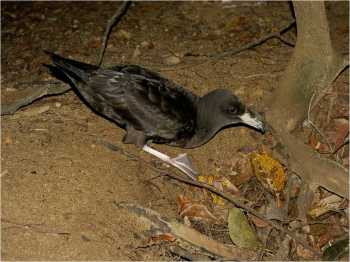Rachel Buxton (Department of Zoology, University of Otago, Dunedin, New Zealand) and colleagues have published in the New Zealand Journal of Ecology on the recovery of seven species of burrowing petrels (Fluttering Shearwater Puffinus gavia, Flesh-footed Shearwater P. carneipes, Little Shearwater P. assimilis, Sooty Shearwater P. griseus, Grey-faced Petrel Pterodroma macroptera gouldi, Pycroft’s Petrel P. pycrofti and Common Diving Petrel Pelecanoides urinatrix) following eradication of rats on New Zealand islands.
The paper’s abstract follows:
“The size and distribution of colonies of burrow-nesting petrels is thought to be limited partly by the availability of suitable breeding habitat and partly by predation. Historically, the availability of safe nesting habitat was restricted in New Zealand, due to the introduction of rats by humans. More recently, however, habitat has been restored by rat eradication. Petrel colony growth is mediated by both positive and negative density dependence, although it is unclear if, or how, density dependence will affect patterns in post-eradication colony recovery. Here, using burrow density as a proxy for relative abundance, we tested whether petrel colonies increase in density or area after rat eradication by sampling along a chronosequence of (1) five islands from which rats were eliminated 1 to 26 years ago, (2) two islands that never had rats, and (3) an island with rats still present, while controlling for habitat availability. We also measured a time series of burrow densities in plots on each island to compare temporal changes after rat eradication. Using Bayesian hierarchical modelling, after controlling for nesting habitat, we found that mean burrow density increased with time since rat eradication. Burrows remained clustered (i.e. spatially structured), but became more randomly distributed on islands with more time since eradication. Point density mapping indicated that colony extent increased with time since rat eradication, with colonies filling over 70% of surveyed areas on islands by 25 years after eradication. Increases in burrow density and colony area, but maintenance of clustered distribution, suggest both positive and negative density dependence may operate during colony expansion. Understanding patterns in petrel colony recovery is important, not only due to the indispensable role of petrels as island ecosystem engineers, reflecting the recovery of ecosystem functioning, but also to help guide post-eradication monitoring strategies.”

Flesh-footed Shearwater, photograph by Barry Baker
Reference:
Buxton, R., Taylor, G., Jones, C., Lyver, P.O’B, Moller, H., Cree, A. & Towns, D. 2016. Spatio-temporal changes in density and distribution of burrow-nesting seabird colonies after rat eradication. New Zealand Journal of Ecology 40(1).
John Cooper, ACAP Information Officer, 03 January 2016

 English
English  Français
Français  Español
Español